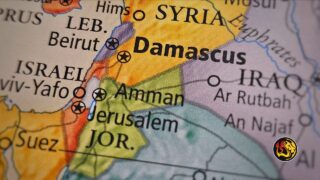by Emmitt Barry, Worthy News Correspondent
(Worthy News) – A historic water spring that has supplied Damascus for thousands of years is now reduced to a trickle, following the driest winter Syria has seen in decades, raising alarms over worsening water shortages across the capital.
Ein al-Fijeh, a once-abundant spring flowing from the ruins of a Roman temple in the Barada Valley, now barely feeds the Barada River or the tunnels that once gushed during winter floods. “I’ve worked here 33 years, and I’ve never seen it this dry,” said Hassan Bashi, a site guard and technician.
The spring provides 70% of the water to Damascus and its suburbs, serving over 5 million people. But with rainfall at its lowest since 1956, authorities are urging residents to ration water. “The spring is at its lowest level,” said Ahmad Darwish of the Damascus Water Authority, warning of even harsher summer conditions.
In neighborhoods like Abbasids, tap water now flows just 90 minutes a day. Bassam Jbara, a resident, said power outages also prevent rooftop pumping. “We are heading toward difficult conditions,” he said, noting some families are already relying on expensive truck-delivered water.
The civil war further damaged the spring’s infrastructure, with shelling and years of fighting around the area. After the fall of the Assad dynasty in 2023, residents like Tarek Abdul-Wahed have returned, trying to rebuild businesses near the spring.
“The Ein al-Fijeh spring is the only artery to Damascus,” Abdul-Wahed said. “Now it looks like a desert.”
Copyright 1999-2025 Worthy News. This article was originally published on Worthy News and was reproduced with permission.
The following code is how the above article is generated with the Worthy Suite WordPress Plugin.
[worthy_plugins_news_story_body]This is how you display a story with an image.
Damascus Faces Severe Water Crisis as Historic Spring Runs Dry

by Emmitt Barry, Worthy News Correspondent
(Worthy News) – A historic water spring that has supplied Damascus for thousands of years is now reduced to a trickle, following the driest winter Syria has seen in decades, raising alarms over worsening water shortages across the capital.
Ein al-Fijeh, a once-abundant spring flowing from the ruins of a Roman temple in the Barada Valley, now barely feeds the Barada River or the tunnels that once gushed during winter floods. “I’ve worked here 33 years, and I’ve never seen it this dry,” said Hassan Bashi, a site guard and technician.
The spring provides 70% of the water to Damascus and its suburbs, serving over 5 million people. But with rainfall at its lowest since 1956, authorities are urging residents to ration water. “The spring is at its lowest level,” said Ahmad Darwish of the Damascus Water Authority, warning of even harsher summer conditions.
In neighborhoods like Abbasids, tap water now flows just 90 minutes a day. Bassam Jbara, a resident, said power outages also prevent rooftop pumping. “We are heading toward difficult conditions,” he said, noting some families are already relying on expensive truck-delivered water.
The civil war further damaged the spring’s infrastructure, with shelling and years of fighting around the area. After the fall of the Assad dynasty in 2023, residents like Tarek Abdul-Wahed have returned, trying to rebuild businesses near the spring.
“The Ein al-Fijeh spring is the only artery to Damascus,” Abdul-Wahed said. “Now it looks like a desert.”
Copyright 1999-2025 Worthy News. This article was originally published on Worthy News and was reproduced with permission.
[worthy_plugins_news_story_title]
<div style="text-align:right; padding:0px 0px 10px 15px; float:right; width:300px;"><img src="[worthy_plugins_news_story_image name=sm_medium]" alt="" /></div>[worthy_plugins_news_story_body]